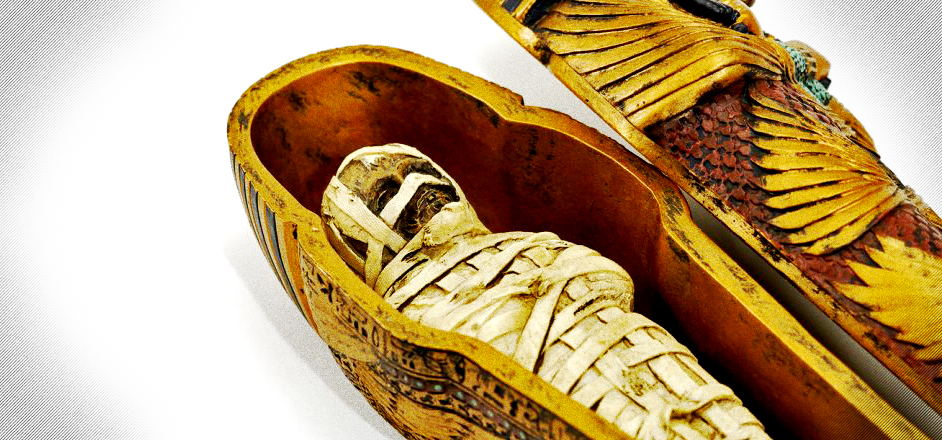Finding cocaine is always an exciting experience — yet one that rarely rewrites ancient history as we know it. Usually the ordeal just ends up in a wild frenzy of deviant debauchery. But sometimes, once in a great while, cocaine is found in a place where it shouldn’t be, and it raises serious questions about how it got there …
Such is the case of the mysterious cocaine mummies. Buried in Egypt over 3000 years ago, these long-dead VIP’s were found with traces of cocaine and nicotine in them. It's an almost inconceivable finding that brings into question everything we thought we knew about human history.
The deeply, disturbingly strange part of all this, is that neither the coca plant (from which cocaine is derived), nor the tobacco plant (which produces nicotine) are native to Egypt. Nor are they native to Africa in general. Or Europe. Or Asia, even. Those two plants are indigenous only to South America.
Which could have some tectonic implications for our perception of history.

Svetlana Balabanova, a German scientist, made the discovery in 1992. She was examining several mummies at the German State Museum of Egyptian Art when she discovered traces of the narcotics in multiple different ancient corpses. She realized how severe the implications of her findings were, so she tested, and re-tested, and tested her results again to be certain that there was no mistake.
Sure enough, there wasn’t. American drugs had, somehow, ended up in these Egyptian mummies.
Previously, Balabanova had worked as a forensic toxicologist for police in Germany and for years her results were considered “proof-positive” in criminal indictments. So, naturally, she thought that that would be the case in this instance as well; especially considering that she was using exactly the same drug testing procedures.
But when Balanbanova went public, she was met with utter contempt from her colleagues and the historical community at large. They hated the idea of what her findings might entail. The whole of ancient history would need to be re-examined, re-written, and re-evaluated through the lens of this new information; that the ancient Egyptians and the ancient Mesoamericans had achieved transoceanic trade.
As the accepted story goes, the Americas were only “discovered” 526 years ago by a sociopathic, genocidal rapist known as Christopher Columbus. The savage bastard even got a holiday for his "discovery" — even though Leif Eriksson and his Vikings had already traveled and settled in North America some 500 years prior to 1492 “when Columbus sailed the ocean blue”.
But had someone else beat even those early Scandinavian explorers? What if, the same mysterious and enigmatic culture that gave us the inexplicable Great Pyramids of Giza, also made that epic oceanic voyage over a thousand years before Columbus and Eriksson?
Surely there would be clues; indicators that the two cultures interacted.
Dr. Erich Fred Legner, a Professor of Biological Control at the University of California, Riverside and Berkley, and an associate at the Riverside Municipal Museum, said that it’s not out of the realm of possibility that the Egyptians traveled all the way to the Americas and back.
“The Egyptians in particular were great navigators well before the Christian era,” he says. “And therefore, could have transported South American drugs back to Egypt.”
Legner’s open-mindedness is not shared by most scholars and academics, though, who dismiss Balabanova’s findings as “contaminated” or “fake” without actually giving her assertion legitimate consideration.
Just take it at face value, though: both the Egyptians and the Ancient cultures of Mesoamerica built pyramids fanatically for spiritual purposes and along directional axes. They both used similar hieroglyphic languages, and they both used substances like mescaline cacti (in the Americas) and morning glory extract, lotus leaves, and poppy seeds (in Egypt) to expand their consciousness’s for religious ceremonies. They were both polytheistic cultures, worshipping a lineup of different gods and goddesses, and their political leaders were viewed as divine.
The two civilizations seem almost like echoes of one another. And until Balabanova discovered a potential link between these two ancient cultures, the similarities could only be chalked up to coincidence, and human nature.
The jury is still very much out, however. Without further evidence that the Egyptians had established transoceanic trade, and brought cocaine and tobacco back to Africa, Balabanova’s findings will likely remain largely ignored. Some scholars also point out that nicotine can come from other sources besides the tobacco plant, and many assert that the cocaine found on the mummies could have been a contamination that happened after the initial discovery of the corpses, or suggest that the mummies were faked altogether.
But, human beings have a tendency to look back on our own history with a measure of arrogance. It’s a filter we learn history through that paints our old-world ancestors in a primitive, underdeveloped light; an assumption that previous peoples were less intelligent and less innovative than ourselves because they came earlier. After all, they were not advanced like we are today; they didn’t have iPhones, or the Internet, 3D printers, fidget spinners, or Bluetooth toasters; they were not enlightened like us, and therefore they must have been less capable.
Right. That line of thinking lends itself too easily to confirmation bias; and it’s a subjective and wholly relative comparison, anyway.
All that’s know for certain is this: cocaine and tobacco are native only to the Americas, and yet somehow, coke and nicotine ended up in the mummified remains of multiple different Egyptian mummies. How, or why that happened may never be revealed.



Leave a Reply